The Effects of Logistics Websites’ Technical Factors on the Optimization of Digital Marketing Strategies and Corporate Brand Name
Abstract
1. Introduction
1.1. Digital Marketing in Logistics Companies
1.2. Big Data in Logistics Websites
1.3. Web Analytics Key Performance Indicators (KPIs) and Corporate Brand Name
1.4. Research Hypotheses
2. Materials and Methods
2.1. Selection, Retrieval, and Statistical Analysis
2.2. Exploratory Model Creation
2.3. Agent-Based Model
3. Results
3.1. Statistical Analysis
3.2. Fuzzy Cognitive Map
3.2.1. Adoption of Fuzzy Cognitive Map Scenarios to Analyze the Data
3.3. Adoption of ABM
4. Discussion
5. Conclusions
5.1. Theoretical Implications
5.2. Practical Implications
5.3. Future Research and Limitations
Author Contributions
Funding
Institutional Review Board Statement
Informed Consent Statement
Data Availability Statement
Conflicts of Interest
References
- Statista. Size of the Global Logistics Industry from 2018 to 2024. Available online: https://www.statista.com/statistics/943517/logistics-industry-global-cagr/ (accessed on 3 February 2022).
- de Oliveira, C.L.C.; Laurindo, F.J.B. A Framework of Web Analytics: Deploying the Emergent Knowledge of Customers to Leverage Competitive Advantage. In Proceedings of the International Conference on e-Business, Seville, Spain, 18–21 July 2011; pp. 1–6. [Google Scholar]
- Kumar, V.; Ogunmola, G.A. Web Analytics for Knowledge Creation: A Systematic Review of Tools, Techniques, and Practices. Int. J. Cyber Behav. Psychol. Learn. 2020, 10, 14. [Google Scholar] [CrossRef]
- Sakas, D.P.; Reklitis, D.P. Predictive Model for Estimating the Impact of Technical Issues on Consumers Interaction in Agri-Logistics Websites. In Information and Communication Technologies for Agriculture―Theme IV: Actions; Bochtis, D., Pearson, S., Lampridi, M., Marinoudi, V., Pardalos, P., Eds.; Springer Optimization and Its Applications; Springer: Berlin/Heidelberg, Germany, 2022; ISBN 9783030841553. [Google Scholar]
- Nasiopoulos, D.Κ.; Sakas, D.P.; Trivellas, P. The Role of Digital Marketing in the Development of a Distribution and Logistics Network of Information Technology Companies. In Business Intelligence and Modelling; Springer International Publishing: Cham, Switzerland, 2021; pp. 267–276. ISBN 9783030570644. [Google Scholar]
- Drivas, I.C.; Sakas, D.P.; Giannakopoulos, G.A.; Kyriaki-Manessi, D. Big Data Analytics for Search Engine Optimization. Big Data Cogn. Comput. 2020, 4, 5. [Google Scholar] [CrossRef]
- Day, G.S. Closing the Marketing Capabilities Gap. J. Mark. 2011, 75, 183–195. [Google Scholar] [CrossRef]
- Chaffey, D.; Ellis-Chadwick, F. Digital Marketing: Strategy, Implementation & Practice; Pearson: London, UK, 2019; ISBN 9781292241623. [Google Scholar]
- Sakas, D.P.; Reklitis, D.P. The Impact of Organic Traffic of Crowdsourcing Platforms on Airlines’ Website Traffic and User Engagement. Sustainability 2021, 13, 8850. [Google Scholar] [CrossRef]
- TV Advertising vs. Digital Marketing—Infographic. Available online: https://www.digivate.com/blog/seo/tv-advertising-vs-digital-marketing-infographic/ (accessed on 20 February 2022).
- Bhargava, M. Up keeping with the new era of the digital world: Digital marketing & prospects. Indian Streams Res. J. 2015, 4, 7. [Google Scholar]
- McDonald, M. Marketing Plans: How to Prepare Them, How to Use Them; Wiley: Chichester, UK, 2011; ISBN 9780470669976. [Google Scholar]
- Levy, S.; Gvili, Y. How Credible Is E-Word of Mouth across Digital-Marketing Channels? The Roles of Social Capital, Information Richness, and Interactivity. J. Advert. Res. 2015, 55, 95–109. [Google Scholar] [CrossRef]
- Sakas, D.P.; Kamperos, I.D.G.; Reklitis, D.P.; Giannakopoulos, N.T.; Nasiopoulos, D.K.; Terzi, M.C.; Kanellos, N. The Effectiveness of Centralized Payment Network Advertisements on Digital Branding during the COVID-19 Crisis. Sustainability 2022, 14, 3616. [Google Scholar] [CrossRef]
- Zelenkauskaite, A.; Simões, B. Big Data through Cross-Platform Interest-Based Interactivity. In Proceedings of the 2014 International Conference on Big Data and Smart Computing (BIGCOMP), Bangkok, Thailand, 15–17 January 2014; pp. 191–196. [Google Scholar]
- Sakas, D.P.; Giannakopoulos, N.T.; Reklitis, D.P.; Dasaklis, T.K. The Effects of Cryptocurrency Trading Websites on Airlines’ Advertisement Campaigns. J. Theor. Appl. Electron. Commer. Res. 2021, 16, 3099–3119. [Google Scholar] [CrossRef]
- Wang, G.; Gunasekaran, A.; Ngai, E.W.T.; Papadopoulos, T. Big Data Analytics in Logistics and Supply Chain Management: Certain Investigations for Research and Applications. Int. J. Prod. Econ. 2016, 176, 98–110. [Google Scholar] [CrossRef]
- Erevelles, S.; Fukawa, N.; Swayne, L. Big Data Consumer Analytics and the Transformation of Marketing. J. Bus. Res. 2016, 69, 897–904. [Google Scholar] [CrossRef]
- Sejnowski, T.J.; Churchland, P.S.; Movshon, J.A. Putting Big Data to Good Use in Neuroscience. Nat. Neurosci. 2014, 17, 1440–1441. [Google Scholar] [CrossRef] [PubMed]
- Woo, S.E.; Tay, L.; Proctor, R.W. Big Data in Psychological Research. In American Psychological Association; American Psychological Association: Washington, DC, USA, 2020; ISBN 9781433831676. [Google Scholar]
- LaValle, S.; Lesser, E.; Shockley, R.; Hopkins, M.S.; Kruschwitz, N. Big Data, Analytics and the Path from Insights to Value. MIT Sloan Manag. Rev. 2011, 52, 21–32. [Google Scholar]
- Knox, B.M.W. Thucydides and The Peloponnesian War: Politics and Power. Nav. War Coll. Rev. 1973, 25, 3–15. [Google Scholar]
- Kubina, M.; Varmus, M.; Kubinova, I. Use of Big Data for Competitive Advantage of Company. Procedia Econ. Financ. 2015, 26, 561–565. [Google Scholar] [CrossRef]
- Bartosik-Purgat, M.; Ratajczak-Mrożek, M. Big Data Analysis as a Source of Companies’ Competitive Advantage: A Review. Entrep. Bus. Econ. Rev. 2018, 6, 197–215. [Google Scholar] [CrossRef]
- Gandomi, A.; Haider, M. Beyond the Hype: Big Data Concepts, Methods, and Analytics. Int. J. Inf. Manag. 2015, 35, 137–144. [Google Scholar] [CrossRef]
- Emmanuel, I.; Stanier, C. Defining Big Data. In Proceedings of the International Conference on Big Data and Advanced Wireless Technologies, Association for Computing Machinery, Blagoevgrad, Bulgaria, 10 November 2016; pp. 1–6. [Google Scholar]
- Khan, M.A.-U.-D.; Uddin, M.F.; Gupta, N. Seven V’s of Big Data Understanding Big Data to Extract Value. In Proceedings of the 2014 Zone 1 Conference of the American Society for Engineering Education, Bridgeport, CT, USA, 3–5 April 2014; pp. 1–5. [Google Scholar]
- Coforge.com. Understanding The 3 Vs of Big Data—Volume, Velocity and Variety? Available online: https://www.coforge.com/salesforce/blog/data-analytics/understanding-the-3-vs-of-big-data-volume-velocity-and-variety/ (accessed on 20 February 2022).
- Teradata What Are the 5 V’s of Big Data? Available online: https://www.teradata.com/Glossary/What-are-the-5-V-s-of-Big-Data (accessed on 20 February 2022).
- Ertemel, A.V. Consumer Insight as Competitive Advantage Using Big Data and Analytics. Int. J. Commer. Financ. 2015, 1, 45–51. [Google Scholar]
- Verma, J.P.; Agrawal, S.; Patel, B.; Patel, A. Big Data Analytics: Challenges and Applications for Text, Audio, Video, and Social Media Data. Int. J. Soft Comput. Artif. Intell. Appl. (IJSCAI) 2016, 5, 41–51. [Google Scholar] [CrossRef]
- Ghani, N.A.; Hamid, S.; Targio Hashem, I.A.; Ahmed, E. Social Media Big Data Analytics: A Survey. Comput. Human Behav. 2019, 101, 417–428. [Google Scholar] [CrossRef]
- Alam, A.; Ullah, I.; Lee, Y.-K. Video Big Data Analytics in the Cloud: A Reference Architecture, Survey, Opportunities, and Open Research Issues. IEEE Access 2020, 8, 152377–152422. [Google Scholar] [CrossRef]
- Tavana, M.; Shaabani, A.; Raeesi Vanani, I.; Kumar Gangadhari, R. A Review of Digital Transformation on Supply Chain Process Management Using Text Mining. Processes 2022, 10, 842. [Google Scholar] [CrossRef]
- Govindan, K.; Cheng, T.C.E.; Mishra, N.; Shukla, N. Big data analytics and application for logistics and supply chain management. Transp. Res. Part E Logist. Trans. Rev. 2018, 114, 343–349. [Google Scholar] [CrossRef]
- Sodero, A.; Henry, J.Y.; Barratt, M. The social process of Big Data and predictive analytics use for logistics and supply chain management. Int. J. Phys. Distrib. Logist. Manag. 2019, 49, 706–726. [Google Scholar] [CrossRef]
- Jeble, S.; Kumari, S.; Patil, Y. Role of Big Data and Predictive Analytics. Int. J. Autom. Logist. 2016, 2, 307–331. [Google Scholar] [CrossRef]
- Dubey, R.; Gunasekaran, A.; Childe, S.J.; Papadopoulos, T.; Luo, Z.; Wamba, S.F.; Roubaud, D. Can Big Data and Predictive Analytics Improve Social and Environmental Sustainability? Technol. Forecast. Soc. Chang. 2019, 144, 534–545. [Google Scholar] [CrossRef]
- Bradlow, E.T.; Gangwar, M.; Kopalle, P.; Voleti, S. The Role of Big Data and Predictive Analytics in Retailing. J. Retail. 2017, 93, 79–95. [Google Scholar] [CrossRef]
- Hazen, B.T.; Skipper, J.B.; Ezell, J.D.; Boone, C.A. Big Data and Predictive Analytics for Supply Chain Sustainability: A Theory-Driven Research Agenda. Comput. Ind. Eng. 2016, 101, 592–598. [Google Scholar] [CrossRef]
- Ayhan, S.; Pesce, J.; Comitz, P.; Sweet, D.; Bliesner, S.; Gerberick, G. Predictive Analytics with Aviation Big Data. In Proceedings of the 2013 Integrated Communications, Navigation and Surveillance Conference (ICNS), Herndon, VA, USA, 22–25 April 2013; pp. 1–13. [Google Scholar]
- Schoenherr, T.; Speier-Pero, C. Data Science, Predictive Analytics, and Big Data in Supply Chain Management: Current State and Future Potential. J. Bus. Logist. 2015, 36, 120–132. [Google Scholar] [CrossRef]
- Gunasekaran, A.; Papadopoulos, T.; Dubey, R.; Wamba, S.F.; Childe, S.J.; Hazen, B.; Akter, S. Big Data and Predictive Analytics for Supply Chain and Organizational Performance. J. Bus. Res. 2017, 70, 308–317. [Google Scholar] [CrossRef]
- Waller, M.A.; Fawcett, S.E. Data Science, Predictive Analytics, and Big Data: A Revolution That Will Transform Supply Chain Design and Management. J. Bus. Logist. 2013, 34, 77–84. [Google Scholar] [CrossRef]
- Alazab, A.; Bevinakoppa, S.; Khraisat, A. Maximising Competitive Advantage on E-Business Websites: A Data Mining Approach. In Proceedings of the 2018 IEEE Conference on Big Data and Analytics (ICBDA), Langkawi, Malaysia, 21–22 November 2018; pp. 111–116. [Google Scholar]
- Christov, A.; Hausmann, V.; Williams, S. Measuring Brand Awareness, Campaign Evaluation and Web Analytics. Digit. Soc. Media 2020, 296, 21. [Google Scholar]
- Peterson, E.T. Web Analytics Demystified: A Marketer’s Guide to Understanding How Your Web Site Affects Your Business; Celilo Group Media: Portland, OR, USA, 2004; ISBN 9780974358420. [Google Scholar]
- Järvinen, J.; Karjaluoto, H. The Use of Web Analytics for Digital Marketing Performance Measurement. Ind. Mark. Manag. 2015, 50, 117–127. [Google Scholar] [CrossRef]
- Statista. The World’s Leading Third-Party Logistics Providers in 2020, Based on Gross Logistics Revenue (in Million U.S. Dollars) *. Available online: https://www.statista.com/statistics/250879/leading-third-party-logistics-providers-worldwide-based-on-revenue/ (accessed on 3 February 2022).
- Saura, J.R.; Palos-Sánchez, P.; Cerdá Suárez, L.M. Understanding the Digital Marketing Environment with KPIs and Web Analytics. Future Internet 2017, 9, 76. [Google Scholar] [CrossRef]
- Kirsh, I.; Joy, M. Splitting the Web Analytics Atom: From Page Metrics and KPIs to Sub-Page Metrics and KPIs. In Proceedings of the 10th International Conference on Web Intelligence, Mining and Semantics; Association for Computing Machinery: New York, NY, USA, 2020; pp. 33–43. [Google Scholar]
- Warren, J. Key Performance Indicators (KPI)–Definition and Action; ATI: London, UK, 2011. [Google Scholar]
- Baye, M.R.; De los Santos, B.; Wildenbeest, M.R. Search Engine Optimization: What Drives Organic Traffic to Retail Sites? J. Econ. Manag. Strategy 2016, 25, 6–31. [Google Scholar] [CrossRef]
- Chen, D.; Jin, J.; Zhang, W.; Pan, F.; Niu, L.; Yu, C.; Wang, J.; Li, H.; Xu, J.; Gai, K. Learning to Advertise for Organic Traffic Maximization in E-Commerce Product Feeds. In Proceedings of the 28th ACM International Conference on Information and Knowledge Management, Biarritz, France, 30 June 2020; pp. 2527–2535. [Google Scholar]
- GTmetrix New Performance Timings Available/Default to Fully Loaded Time. Available online: https://gtmetrix.com/blog/new-performance-timings-available-default-to-fully-loaded-time/ (accessed on 21 February 2022).
- Manhas, J. Comparative Study of Website Page Size as Design Issue in Various Websites. Int. J. Inf. Eng. Electron. Bus. 2014, 6, 33–39. [Google Scholar] [CrossRef][Green Version]
- Libert, T. Exposing the Hidden Web: An Analysis of Third-Party HTTP Requests on 1 Million Websites. arXiv 2015, arXiv:1511.00619. [Google Scholar]
- Vyas, C. Evaluating State Tourism Websites Using Search Engine Optimization Tools. Tourism Manag. 2019, 73, 64–70. [Google Scholar] [CrossRef]
- Sculley, D.; Malkin, R.G.; Basu, S.; Bayardo, R.J. Predicting Bounce Rates in Sponsored Search Advertisements. In Proceedings of the 15th ACM SIGKDD International Conference on Knowledge Discovery and data Mining, Paris, France, 28 June 2009; pp. 1325–1334. [Google Scholar]
- Semrush. Traffic Analytics Overview Report Manual. Available online: https://www.semrush.com/kb/895-traffic-analytics-overview-report (accessed on 23 February 2022).
- Plaza, B. Google Analytics for Measuring Website Performance. Tourism Manag. 2011, 32, 477–481. [Google Scholar] [CrossRef]
- Wolk, A.; Theysohn, S. Factors Influencing Website Traffic in the Paid Content Market. J. Mark. Manag. 2007, 23, 769–796. [Google Scholar] [CrossRef]
- Blake, T.; Nosko, C.; Tadelis, S. Consumer Heterogeneity and Paid Search Effectiveness: A Large-Scale Field Experiment. Econometrica 2015, 83, 155–174. [Google Scholar] [CrossRef]
- Wanichayapong, N.; Pruthipunyaskul, W.; Pattara-Atikom, W.; Chaovalit, P. Social-Based Traffic Information Extraction and Classification. In Proceedings of the 2011 11th International Conference on ITS Telecommunications, St. Petersburg, Russia, 23–25 August 2011; pp. 107–112. [Google Scholar]
- Parmenter, D. Key Performance Indicators: Developing, Implementing, and Using Winning KPIs; John Wiley & Sons: Hoboken, NJ, USA, 2015; ISBN 9781119620778. [Google Scholar]
- Chessell, M.; Scheepers, F.; Nguyen, N.; van Kessel, R.; van der Starre, R. Governing and Managing Big Data for Analytics and Decision Makers. IBM Redguides Bus. Lead. 2014, 1, 28. [Google Scholar]
- Nakatani, K.; Chuang, T. A Web Analytics Tool Selection Method: An Analytical Hierarchy Process Approach. Internet Res. 2011, 21, 171–186. [Google Scholar] [CrossRef]
- Gour, A.; Aggarwal, S.; Erdem, M. Reading between the Lines: Analyzing Online Reviews by Using a Multi-Method Web-Analytics Approach. Int. J. Contemp. Hosp. Manag. 2021, 33, 490–512. [Google Scholar] [CrossRef]
- Lamberz, J.; Litfin, T.; Meeh-Bunse, G.; Teckert, Ö. User-Friendly Website Design: A Combined Eye-Tracking Study. In Proceedings of the ENTRENOVA—ENTerprise REsearch InNOVAtion, Dubrovnik, Croatia, 7–9 September 2017; IRENET—Society for Advancing Innovation and Research in Economy: Zagreb, Croatia, 2017; Volume 3, pp. 308–315. [Google Scholar]
- Nasiopoulos, D.Κ.; Sakas, D.P.; Reklitis, P. The Interaction of Users’ Behavior to the Development of a Distribution and Logistics Network of the Information Technology Companies. In Business Intelligence and Modelling; Springer International Publishing: Cham, Switzerland, 2021; pp. 219–227. ISBN 9783030570644. [Google Scholar]
- Denga, E.M.; Vajjhala, N.R.; Rakshit, S. The Role of Digital Marketing in Achieving Sustainable Competitive Advantage. In Digital Transformation and Internationalization Strategies in Organizations; IGI Global: Hershey, PA, USA, 2022; pp. 44–60. [Google Scholar]
- Singla, M.L.; Apoorv, D. How Social Media Gives You Competitive Advantage. Indian J. Sci. Technol. 2015, 8, 90. [Google Scholar] [CrossRef]
- Rao, R.J.; Stewart, C.; Perez, A.; Renganathan, S.M. Assessing Learning Behavior and Cognitive Bias from Web Logs. In Proceedings of the 2018 IEEE Frontiers in Education Conference (FIE), San Jose, CA, USA, 3–6 October 2018; pp. 1–5. [Google Scholar]
- Pohl, M.; Winter, L.-C.; Pallaris, C.; Attfield, S.; Wong, B.L.W. Sensemaking and Cognitive Bias Mitigation in Visual Analytics. In Proceedings of the 2014 IEEE Joint Intelligence and Security Informatics Conference, The Hague, The Netherlands, 24–26 September 2014; p. 323. [Google Scholar]
- Giabbanelli, P.J.; Gray, S.A.; Aminpour, P. Combining Fuzzy Cognitive Maps with Agent-Based Modeling: Frameworks and Pitfalls of a Powerful Hybrid Modeling Approach to Understand Human-Environment Interactions. Environ. Model. Softw. 2017, 95, 320–325. [Google Scholar] [CrossRef]
- Statista. Logistics Companies Worldwide in 2020, Based on Logistics Revenue. Available online: https://www.statista.com/statistics/270168/logistics-companies-worldwide-by-revenue/ (accessed on 25 February 2022).
- Felix, G.; Nápoles, G.; Falcon, R.; Froelich, W.; Vanhoof, K.; Bello, R. A Review on Methods and Software for Fuzzy Cognitive Maps. Artif. Intell. Rev. 2019, 52, 1707–1737. [Google Scholar] [CrossRef]
- Behrooz, F.; Mariun, N.; Marhaban, M.H.; Mohd Radzi, M.A.; Ramli, A.R. Review of Control Techniques for HVAC Systems—Nonlinearity Approaches Based on Fuzzy Cognitive Maps. Energies 2018, 11, 495. [Google Scholar] [CrossRef]
- Sakas, D.P.; Giannakopoulos, N.T. Big Data Contribution in Desktop and Mobile Devices Comparison, Regarding Airlines’ Digital Brand Name Effect. Big Data Cogn. Comput. 2021, 5, 48. [Google Scholar] [CrossRef]
- Negahban, A.; Yilmaz, L. Agent-Based Simulation Applications in Marketing Research: An Integrated Review. J. Simul. 2014, 8, 129–142. [Google Scholar] [CrossRef]
- Rand, W.; Rust, R.T. Agent-Based Modeling in Marketing: Guidelines for Rigor. Int. J. Res. Mark. 2011, 28, 181–193. [Google Scholar] [CrossRef]
- Hubspot. 12 Statistics That Show How Page Load Time Impacts Conversion Rate. Available online: https://blog.hubspot.com/marketing/page-load-time-conversion-rates (accessed on 25 February 2022).
- Son, C.; Kim, J.; Kim, Y. Developing Scenario-Based Technology Roadmap in the Big Data Era: An Utilisation of Fuzzy Cognitive Map and Text Mining Techniques. Technol. Anal. Strateg. Manag. 2020, 32, 272–291. [Google Scholar] [CrossRef]
- Salmeron, J.L. Supporting Decision Makers with Fuzzy Cognitive Maps. Res.-Technol. Manag. 2009, 52, 53–59. [Google Scholar] [CrossRef]
- Yamagishi, K.; Ocampo, L.; Abellana, D.P.; Tanaid, R.A.; Tiu, A.M.; Medalla, M.E.; Selerio, E.; Go, C.; Olorvida, R.C.; Maupo, A.; et al. The Impact of Social Media Marketing Strategies on Promoting Sustainability of Tourism with Fuzzy Cognitive Mapping: A Case of Kalanggaman Island (Philippines). Environ. Dev. Sustain. 2021, 23, 14998–15030. [Google Scholar] [CrossRef]
- Tsadiras, A.K. Comparing the Inference Capabilities of Binary, Trivalent and Sigmoid Fuzzy Cognitive Maps. Inf. Sci. 2008, 178, 3880–3894. [Google Scholar] [CrossRef]
- Hamill, L.; Gilbert, G. Social Circles: A Simple Structure for Agent-Based Social Network Models. J. Artif. Soc. Soc. Simul. 2009, 12, 1–3. [Google Scholar]
- Hoertel, N.; Blachier, M.; Blanco, C.; Olfson, M.; Massetti, M.; Rico, M.S.; Limosin, F.; Leleu, H. Author Correction: A Stochastic Agent-Based Model of the SARS-CoV-2 Epidemic in France. Nat. Med. 2020, 26, 1801. [Google Scholar] [CrossRef]
- Ismail, A.R. The Influence of Perceived Social Media Marketing Activities on Brand Loyalty: The Mediation Effect of Brand and Value Consciousness. Asia Pac. J. Mark. Logist. 2017, 29, 129–144. [Google Scholar] [CrossRef]
- Rajiullah, M.; Mohideen, A.C.; Weinrank, F.; Secchi, R.; Fairhurst, G.; Brunstrom, A. Understanding Multistreaming for Web Traffic: An Experimental Study. In Proceedings of the 2017 IFIP Networking Conference (IFIP Networking) and Workshops, Stockholm, Sweden, 12–16 June 2017; pp. 1–6. [Google Scholar]
- Secchi, R.; Sathiaseelan, A.; Fairhurst, G. Evaluating Web Traffic Performance over DVB-RCS2. In Proceedings of the Personal Satellite Services, Bradford, UK, 22 March 2012; pp. 148–155. [Google Scholar]
- Orji, I.J.; Kusi-Sarpong, S.; Gupta, H. The Critical Success Factors of Using Social Media for Supply Chain Social Sustainability in the Freight Logistics Industry. Int. J. Prod. Res. 2020, 58, 1522–1539. [Google Scholar] [CrossRef]
- Denktaş-Şakar, G.; Sürücü, E. Stakeholder Engagement via Social Media: An Analysis of Third-Party Logistics Companies. Serv. Ind. J. 2020, 40, 866–889. [Google Scholar] [CrossRef]
- Wang, X.; Kochtanek, T.; Borwick, J.B. Comparing Image Users and Uses with Web Analytics. Proc. Am. Soc. Inf. Sci. Technol. 2010, 47, 1–2. [Google Scholar] [CrossRef]
- Trueger, N.S.; Bokarius, A.V.; Carroll, S.; April, M.D.; Thoma, B. Impact of a Physician-Led Social Media Sharing Program on a Medical Journal’s Web Traffic. J. Am. Coll. Radiol. 2018, 15, 184–189. [Google Scholar] [CrossRef] [PubMed]
- Erdoğmuş, İ.E.; Çiçek, M. The Impact of Social Media Marketing on Brand Loyalty. Procedia-Soc. Behav. Sci. 2012, 58, 1353–1360. [Google Scholar] [CrossRef]
- Serbetcioglu, C.; Göçer, A. Examining Social Media Branding Profiles of Logistics Service Providers. J. Bus. Ind. Mark. 2020, 35, 2023–2038. [Google Scholar] [CrossRef]
- Cheung, M.L.; Pires, G.; Rosenberger, P.J. The Influence of Perceived Social Media Marketing Elements on Consumer–brand Engagement and Brand Knowledge. Asia Pac. J. Mark. Logist. 2020, 39, 88. [Google Scholar] [CrossRef]
- Reklitis, P.; Trivellas, P.; Mantzaris, I.; Mantzari, E.; Reklitis, D. Employee Perceptions of Corporate Social Responsibility Activities and Work-Related Attitudes: The Case of a Greek Management Services Organization. In Sustainability and Social Responsibility: Regulation and Reporting; Gal, G., Akisik, O., Wooldridge, W., Eds.; Springer: Singapore, 2018; pp. 225–240. ISBN 9789811045028. [Google Scholar]
- Constantinescu, M.; Orindaru, A.; Pachitanu, A.; Rosca, L.; Caescu, S.-C.; Orzan, M.C. Attitude Evaluation on Using the Neuromarketing Approach in Social Media: Matching Company’s Purposes and Consumer’s Benefits for Sustainable Business Growth. Sustain. Sci. Pract. Policy 2019, 11, 7094. [Google Scholar] [CrossRef]
- Mills, K.A. What Are the Threats and Potentials of Big Data for Qualitative Research? Qual. Res. 2018, 18, 591–603. [Google Scholar] [CrossRef]
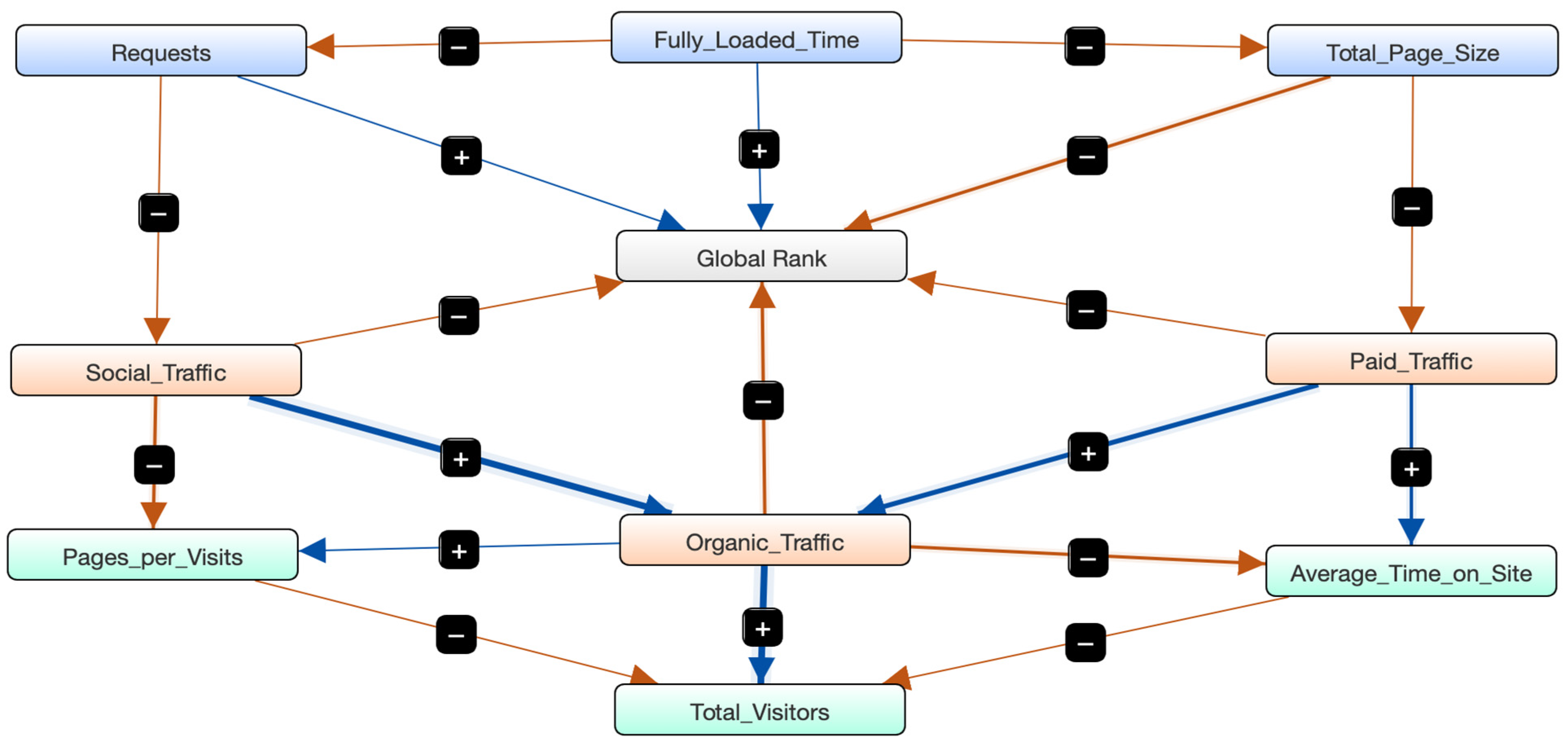

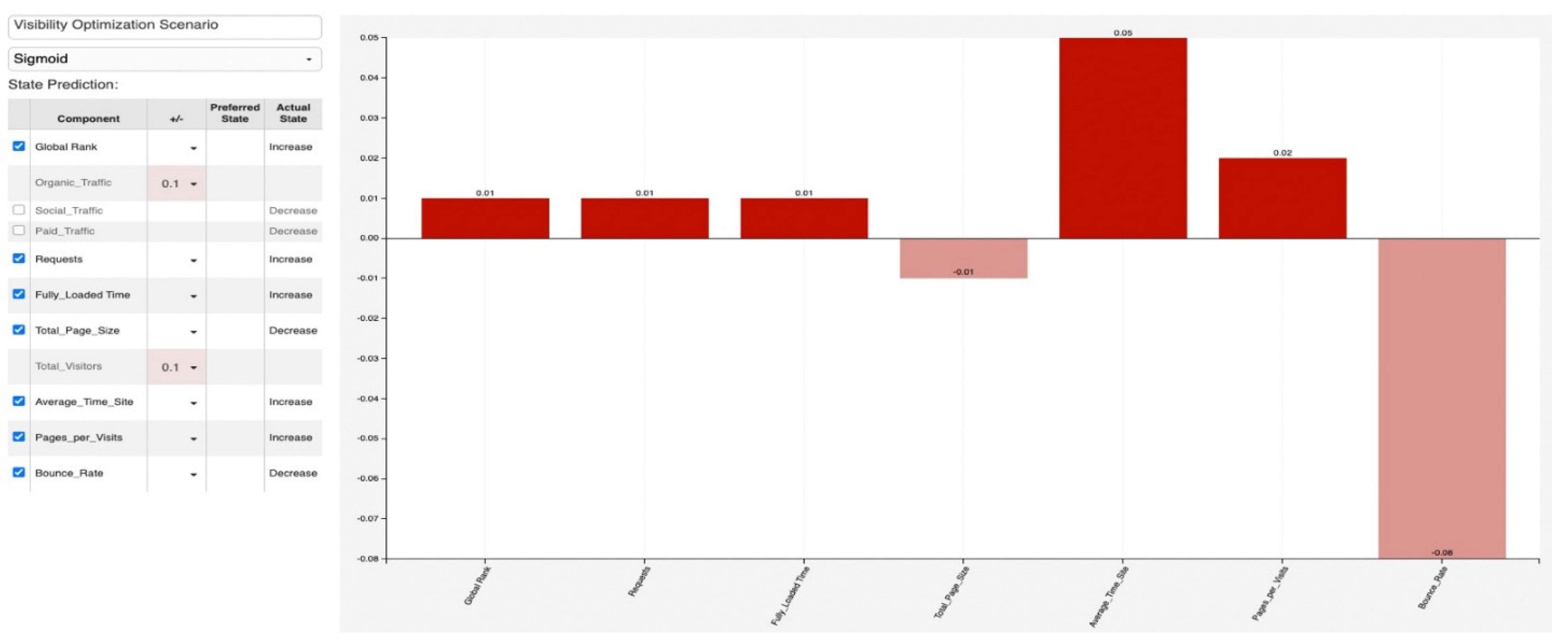
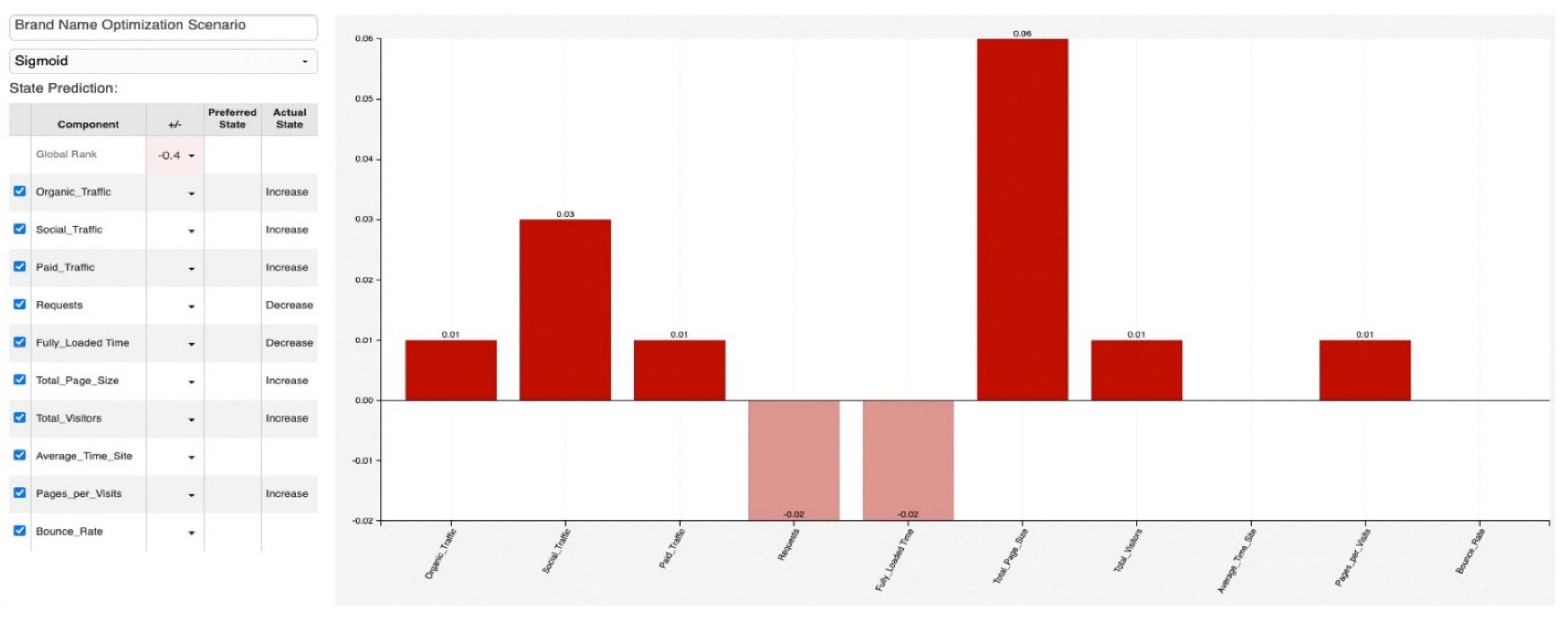
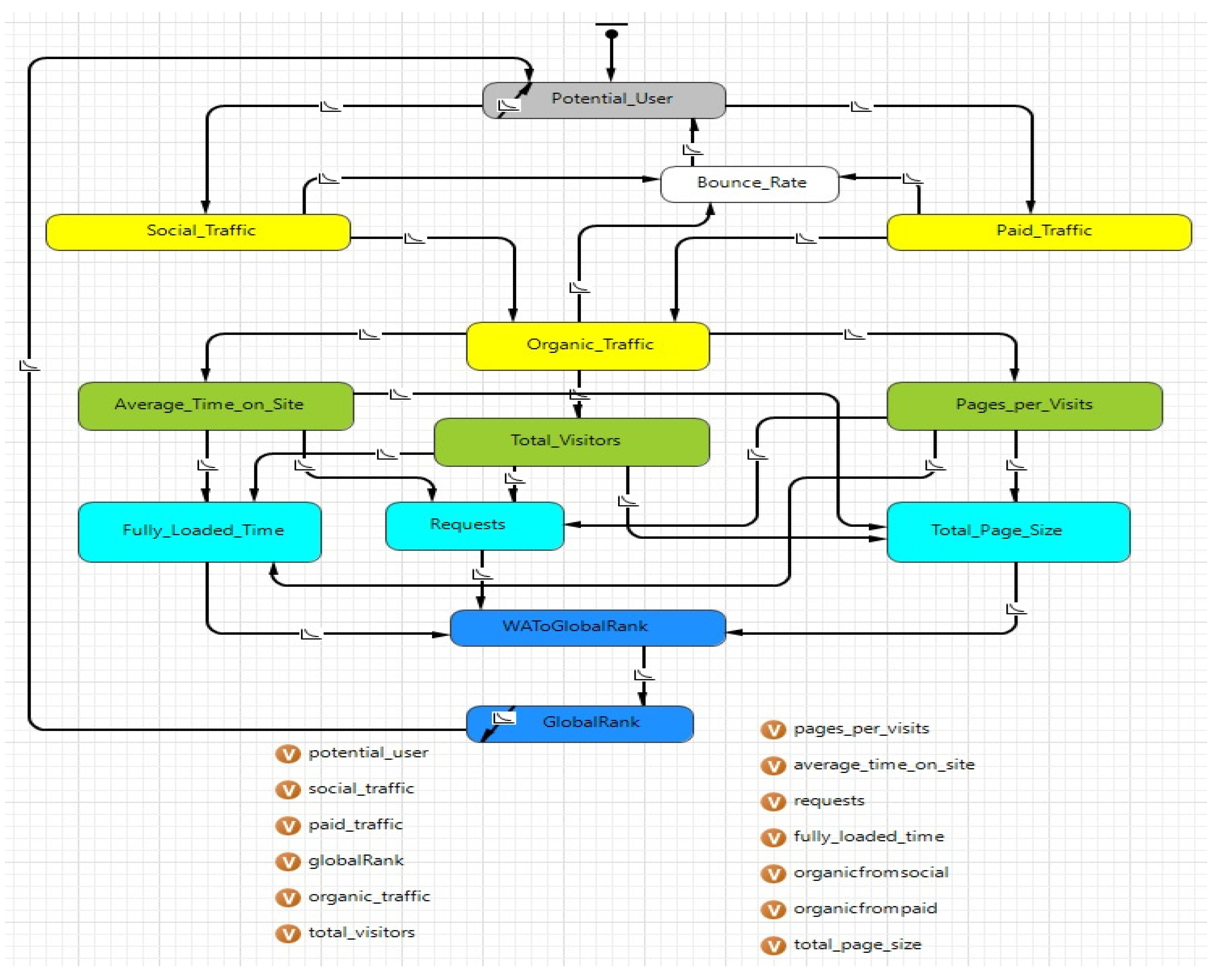
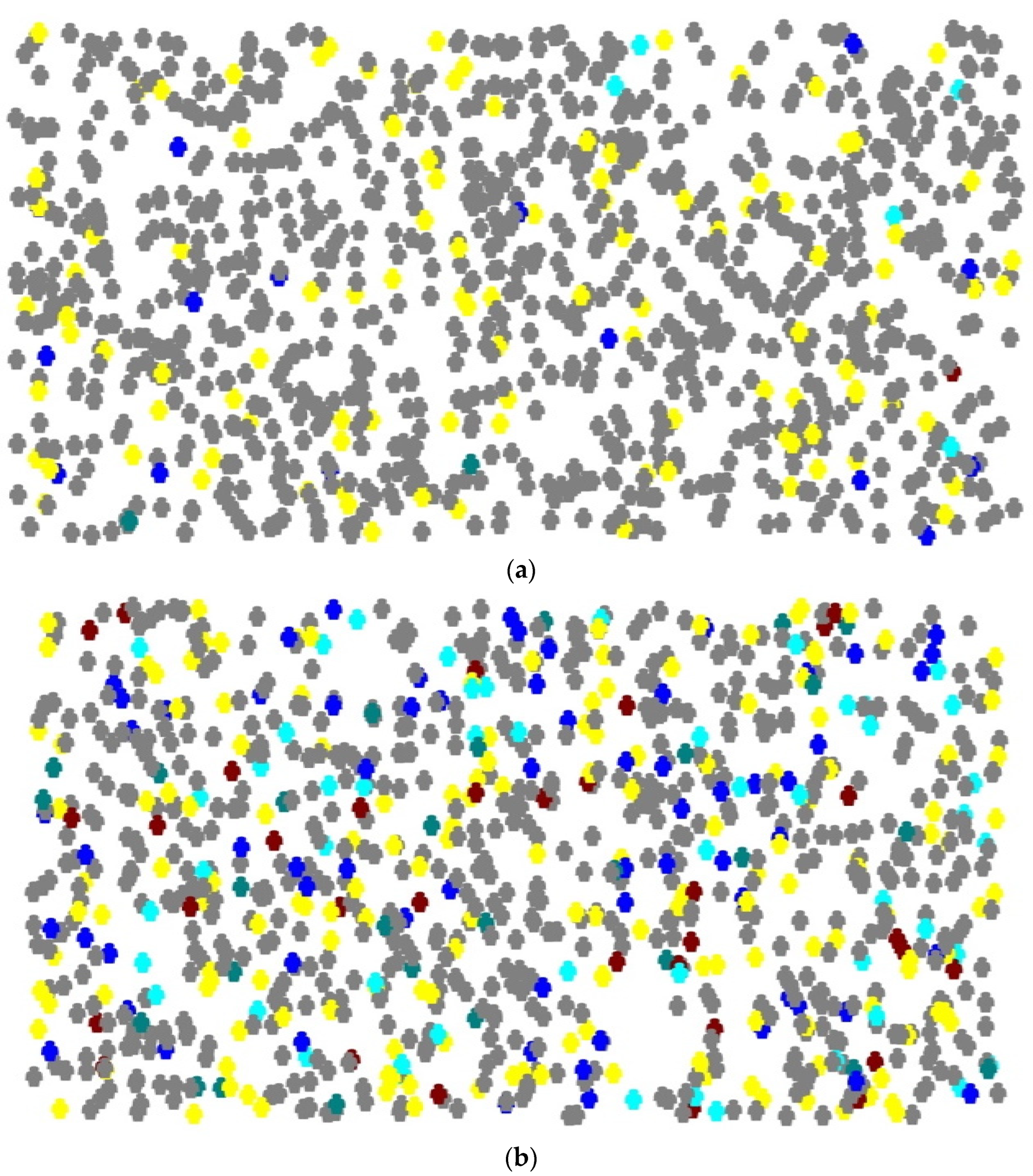



| Web Analytics KPIs | Description of the Web Analytics KPIs |
|---|---|
| Organic Traffic | Organic traffic refers to users that arrive at the corporate website through a non-paid way [9,53,54]. |
| Fully Loaded Time | According to GTmetrix, Fully Loaded Time refers to the time in seconds that it takes for a website to fully load [55]. |
| Total Page Size | The sum of the totality of the components required to load a website is referred to as Total Page Size. This contains the HTML and CSS, as well as the pictures [56]. |
| Requests | The number of requests necessary to render a website is reduced as the number of elements on the page is reduced, resulting in quicker page loading [57]. |
| Global Rank | This WA Key Performance Indicator is derived from the overall traffic on the platform, including organic, social, and paid traffic. The lower the worldwide rank, the more well-known the website, since a website in the 1st place has a better ranking in comparison to a website in the 15th place [14,58]. |
| Bounce Rate | When a customer enters a website and immediately exits without seeing anything more, this is known as a bounce rate [59]. |
| Average Time on Site | This KPI measures how long a user remains on a corporate website [60]. |
| Pages per Visit | When users enter a corporate webpage, they view a number of pages; the KPI “Pages per Visits” calculates this number [61]. |
| Paid Traffic | Paid Traffic is generated solely through paid methods. For instance, when a user selects a Google ad and is redirected to the corporate website. [62,63]. |
| Social Traffic | When a user is redirected from Facebook, Instagram, or social media in general to the corporate website, it produces the KPI Social Traffic. [60,64]. This research is limited to Instagram and Facebook. |
| Total Visitors | This KPI calculates the total number of users that enter a corporate website each day [60,65]. |
| Mean | Min | Max | Std. Deviation | |
|---|---|---|---|---|
| Webpages’ Organic Traffic | 31,199,621.47 | 3,123,349.00 | 67,839,204.00 | 19,997,235.96 |
| Webpages’ Paid Traffic | 445,757.35 | 11,435.00 | 1,564,843.00 | 502,902.50 |
| Webpages’ Average Time on Site | 517.69 | 412.00 | 766.00 | 103.45 |
| Webpages’ Bounce Rate | 0.468 | 0.349 | 0.592 | 0.079 |
| Webpages’ Pages/Visit | 2.81 | 2.20 | 3.54 | 0.51 |
| Webpages’ Total Visitors | 141,205,016.26 | 5,418,390.00 | 375,118,623.00 | 128,953,195.18 |
| Webpages’ Global Rank | 11,944.90 | 8983.00 | 14,445.00 | 1900.42 |
| Webpages’ Total Page Size | 1.947 | 0.874 | 9.198 | 1.0784 |
| Webpages’ Requests | 90.80 | 27 | 152 | 24.983 |
| Webpages’ Fully Loaded Time | 4.373 | 1.48 | 49.55 | 3.21452 |
| Webpages’ Social Traffic | 1,410,459.42 | 17,309.00 | 3,837,538.00 | 1,431,734.58 |
| Correlations | Organic Traffic | Total Page Size | Total Visitors |
|---|---|---|---|
| Organic Traffic | 1 | ||
| Total Page Size | 0.033 | 1 | |
| Total Visitors | 0.962 ** | 0.018 | 1 |
| Variables | Standardized Coefficient | R2 | F | p-Value |
|---|---|---|---|---|
| Constant (Organic Traffic) | - | 0.927 | 5357.912 | <0.001 |
| Total Page Size | 0.015 | 0.087 | ||
| Total Visitors | 0.962 ** | 0.000 |
| Correlations | Social Traffic | Fully Loaded Time | Total Visitors |
|---|---|---|---|
| Social Traffic | 1 | ||
| Fully Loaded Time | −0.029 | 1 | |
| Total Visitors | 0.931 ** | −0.012 | 1 |
| Variables | Standardized Coefficient | R2 | F | p-Value |
|---|---|---|---|---|
| Constant (Social Traffic) | - | 0.868 | 2749.090 | 0.683 |
| Fully Loaded Time | −0.018 | 0.150 | ||
| Total Visitors | 0.931 ** | 0.000 |
| Correlations | Paid Traffic | Bounce Rate | Requests |
|---|---|---|---|
| Paid Traffic | 1 | ||
| Bounce Rate | 0.675 ** | 1 | |
| Requests | −0.013 | 0.024 | 1 |
| Variables | Standardized Coefficient | R2 | F | p-Value |
|---|---|---|---|---|
| Constant (Paid Traffic) | - | 0.457 | 351.929 | <0.001 |
| Bounce Rate | 0.676 ** | <0.001 | ||
| Requests | −0.029 | 0.249 |
| Correlations | Paid Traffic | Total Visitors | Average Time on Site |
|---|---|---|---|
| Paid Traffic | 1 | ||
| Total Visitors | 0.766 ** | 1 | |
| Average Time on Site | 0.275 ** | −0.149 ** | 1 |
| Variables | Standardized Coefficient | R2 | F | p-Value |
|---|---|---|---|---|
| Constant (Paid Traffic) | - | 0.742 | 1204.316 | <0.001 |
| Total Visitors | 0.826 ** | <0.001 | ||
| Average Time on Site | 0.398 ** | <0.001 |
| Correlations | Global Rank | Fully Loaded Time | Total Page Size | Requests |
|---|---|---|---|---|
| Global Rank | 1 | |||
| Fully Loaded Time | 0.088 * | 1 | ||
| Total Page Size | −0.268 ** | 0.059 | 1 | |
| Requests | 0.101 ** | −0.071 * | 0.158 * | 1 |
| Variables | Standardized Coefficient | R2 | F | p-Value |
|---|---|---|---|---|
| Constant (Global Rank) | - | 0.107 | 33.291 | <0.001 |
| Fully Loaded Time | 0.117 ** | <0.001 | ||
| Total Page Size | −0.300 ** | <0.001 | ||
| Requests | 0.157 ** | <0.001 |
Publisher’s Note: MDPI stays neutral with regard to jurisdictional claims in published maps and institutional affiliations. |
© 2022 by the authors. Licensee MDPI, Basel, Switzerland. This article is an open access article distributed under the terms and conditions of the Creative Commons Attribution (CC BY) license (https://creativecommons.org/licenses/by/4.0/).
Share and Cite
Sakas, D.P.; Reklitis, D.P.; Trivellas, P.; Vassilakis, C.; Terzi, M.C. The Effects of Logistics Websites’ Technical Factors on the Optimization of Digital Marketing Strategies and Corporate Brand Name. Processes 2022, 10, 892. https://doi.org/10.3390/pr10050892
Sakas DP, Reklitis DP, Trivellas P, Vassilakis C, Terzi MC. The Effects of Logistics Websites’ Technical Factors on the Optimization of Digital Marketing Strategies and Corporate Brand Name. Processes. 2022; 10(5):892. https://doi.org/10.3390/pr10050892
Chicago/Turabian StyleSakas, Damianos P., Dimitrios P. Reklitis, Panagiotis Trivellas, Costas Vassilakis, and Marina C. Terzi. 2022. "The Effects of Logistics Websites’ Technical Factors on the Optimization of Digital Marketing Strategies and Corporate Brand Name" Processes 10, no. 5: 892. https://doi.org/10.3390/pr10050892
APA StyleSakas, D. P., Reklitis, D. P., Trivellas, P., Vassilakis, C., & Terzi, M. C. (2022). The Effects of Logistics Websites’ Technical Factors on the Optimization of Digital Marketing Strategies and Corporate Brand Name. Processes, 10(5), 892. https://doi.org/10.3390/pr10050892








